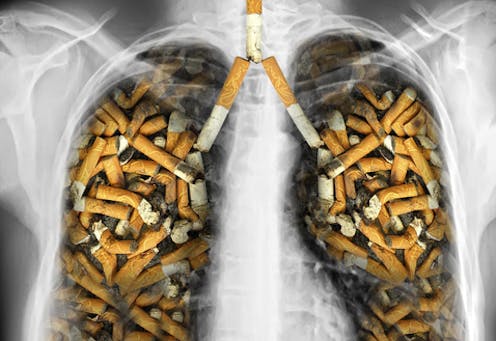April 15 is the day tobacco companies pay $9 billion for tobacco illnesses, but is it enough?
- Written by Charles Betley, Senior Policy Analyst, University of Maryland, Baltimore County

April 15 is Tax Day in the U.S., and it is a bitter pill for many.
For state Medicaid plans, though, which pay a heavy price for tobacco-related illnesses, it can be a shot in the arm of sorts. April 15 is also the day when the five largest tobacco companies pay US$9 billion dollars to state governments[1], each and every year, forever, because of a 1998 legal settlement[2] meant to compensate states for the costs of tobacco-related illness such as cancer, emphysema and heart disease. Actual payments made by the tobacco companies vary year to year because of adjustment factors written into the settlement; each of the states’ payments varies as well.
Payments from tobacco companies, as well as tobacco taxes, help to support health care and other services for low-income people served by state Medicaid programs. Even though the federal government supports each state’s Medicaid program by paying at least half the costs, many states have difficulty finding revenues[3] to pay the remaining share.
Determining how much tobacco use costs states’ Medicaid programs puts the payments from tobacco companies into perspective. One estimate found 15% of nationwide Medicaid costs[4] were caused by tobacco use. But such estimates based on national surveys may not account for which tobacco-related diseases are most prevalent in a particular state. How many of the state’s Medicaid participants smoke, and how hospitals and doctors are paid, also affect a state’s Medicaid costs.
The Center for Mississippi Health Policy[5] was interested in estimating the actual costs to Mississippi Medicaid for treating tobacco-related disease. The center wanted a price tag that more accurately reflected the health-related behaviors of people in Mississippi and health care services available in the state. Our team of researchers from The Hilltop Institute[6] at the University of Maryland, Baltimore County (UMBC) conducted the study. We think our study is the first to focus on Medicaid costs using actual state Medicaid data.
Getting a truer picture
Instead of applying estimates of total costs of smoking from national surveys to individual states as previous studies have done, our research[7] assessed how specific, individual smoking-related illnesses create costs for Mississippi. This lets the state better understand how much it differs from nationwide averages for both its total Medicaid costs and the sources of those costs.
First, we reviewed medical literature for studies that identified how tobacco use or exposure changes the risk of acquiring a particular illness. Many studies of how much smoking increases the risk of getting particular diseases have been conducted since the U.S. surgeon general first reported on the health hazards[8] of smoking in 1964. In 2014, the surgeon general summarized many of these studies in a 50th anniversary report[9].
Some of the diseases we studied, such as prostate cancer, may have many causes in addition to tobacco use. Others, such as lung cancer, are almost always caused by tobacco. Once we found a number specifying how much smoking increased the risk for contracting each disease, we multiplied those risk scores by the percentage of people in Mississippi Medicaid who smoked. That enabled us to estimate what percentage of Mississippi Medicaid spending for each of these diseases was smoking-related. The Mississippi Medicaid program gave us data to determine the cost of each service paid to treat each person with the specific diagnosis.
We then adjusted this initial estimate for other factors that were not captured in the Medicaid payment data. We added adjusted costs for prescription drugs that could be used to treat smoking-related conditions. In addition, many Medicaid participants are in nursing homes because of diseases acquired from smoking. So we added the costs of nursing home stays based on residents’ diagnoses and the same risk scores.
Tobacco use can also affect the health of nonsmokers exposed to second-hand smoke. Mississippi had estimated the costs of second-hand smoke[10] using national estimates. We updated those numbers based on relative risk of tobacco-related diseases we found in the more recent data.
An expensive set of illnesses
In total, we estimated that the cost of tobacco-related illness to Mississippi Medicaid was $388 million in 2016 and $396 million in 2017. This made up about 9% of Mississippi’s annual spending on Medicaid. Our estimates were somewhat lower than the national cost estimates of 15%[11]. We believe this is because Mississippi Medicaid covers large numbers of children and younger adults – a tobacco-related disease may appear only after many years of smoking.
Many Mississippi Medicaid participants may still be too young to be diagnosed with tobacco-related illnesses. Furthermore, our estimates only included diseases with measures of increased risks because of smoking that are presented in the medical literature or the 2014 surgeon general’s report. So, our estimates are relatively conservative.
We believe our study results will help policymakers in Mississippi assess the benefits of policies affecting tobacco. These could include increasing tobacco cessation services, raising the minimum age for buying tobacco products, raising taxes on tobacco products and requiring smoke-free public places. Our approach to estimating costs could also be used by other states to conduct their own analyses of tobacco-related costs to Medicaid to inform their policy choices.
References
- ^ governments (www.publichealthlawcenter.org)
- ^ 1998 legal settlement (publichealthlawcenter.org)
- ^ difficulty finding revenues (www.governing.com)
- ^ 15% of nationwide Medicaid costs (doi.org)
- ^ Center for Mississippi Health Policy (mshealthpolicy.com)
- ^ The Hilltop Institute (hilltopinstitute.org)
- ^ research (www.hilltopinstitute.org)
- ^ reported on the health hazards (profiles.nlm.nih.gov)
- ^ 50th anniversary report (www.surgeongeneral.gov)
- ^ estimated the costs of second-hand smoke (mstobaccodata.org)
- ^ national cost estimates of 15% (doi.org)
Authors: Charles Betley, Senior Policy Analyst, University of Maryland, Baltimore County

